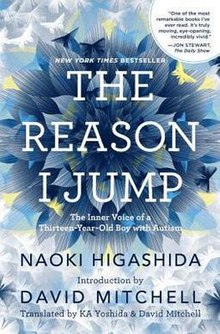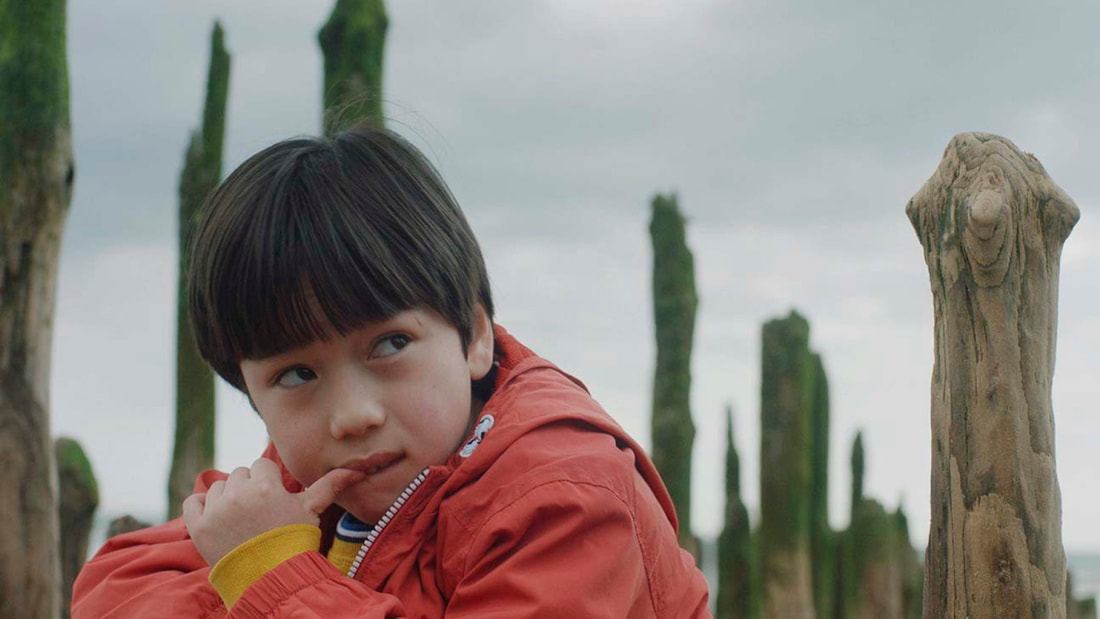|
DISCLAIMER: I strongly encourage you to read The Reason I Jump or watch The Reason I Jump documentary on Netflix before reading this blog post. I'm going to be giving spoilers into the documentary. The Reason I Jump is a book written by a non-verbal, autistic 13 year old boy, Naoki, living in Japan. The book describes the thoughts and feelings of Naoki as he navigates the world being unable to speak. He gives a very detailed account into his life. The Reason I Jump documentary follows the lives of five non-verbal or minimally verbal neurodivergent people. The documentary shows the challenges and victories of living with autism from people around the world. Jerry Rothwell paints the unique sensory experience of those with autism through multiple filming techniques including close-ups and heightened sound. It follows the lives of Joss, Amrit, Ben, Emma and Jestina. Naoki describes his memory with the phrase, “Time is a continuous thing with no clear boundaries, which is why it’s so confusing … I imagine other people’s memories are arranged continuously like a line. My memory is more like a pool of dots – memories are all scattershot and never connected in the right order.” Personally, I would say time can be confusing. For example, if I'm doing a task I enjoy it's hard for me to stop doing it. My long term memories feel like they just happened yesterday and it doesn't matter whether it's a good or bad memory. If I have been overstimulated at work or I am coming back from time in the community, I will turn the lights out at home to block out additional sensory input. Naoki describes his sensory experience as "So how I see the world you may be looking at the exact same thing as me, but how I perceive it maybe different. When you see an object, you see the entire thing, but for me the details appear first and then the entire thing" For me, I would say I notice the details first and then the whole object. It sometimes takes me a minute to figure out what I'm looking at. This makes me be able to see things other people wouldn't recognize or if someone loses something I'm able to find it faster than others. He goes on to say, "Everything has its own unique beauty when a color is vivid or eye catchy, my heart kind of skips a beat and I can't concentrate on anything else." For me, I like looking at things lava lamps, rain falling, looking at pictures and small visual timers. Something about watching it calms me. Music also calms when I play my specific playlists as well as riding in the car. Any noise that's loud or repetitive will drive me nuts. Tapping, a blow dryer, loud music, phones ringing, a dog repeatedly barking. These are all things that I have a hard time handling. If I have been overstimulated at work or I am coming back from time in the community, I will turn the lights out at home to block out additional sensory input. Joss's parents describe his childhood sensory experiences as positive and that they were able to provide what he needed. Joss likes lights and water. I would say my sensory experience was mostly positive, with the exception of my extreme fear of dogs. My mom tells the story of when we were on a walk and I essentially had a meltdown because the dog was across the street. I would be afraid even if it was nowhere near me. I didn't want the dog to jump on me or anything that a dog does. The fear then turned to large dogs as I got older. The only way I got over that was to be around dogs and to have a positive experiences around them. Naoki describes his meltdowns as " There are times I can't act even though I want to. My whole body belongs to someone else as if I'm remote controlling a faulty robot. I feel hopelessness. Even when I make a tiny mistake, it causes a meltdown or panic attack. I'll do anything to get away. I hate myself. I just hate myself." I'm going to say this right away, when a person with autism has a meltdown they have no control over themselves. They're not doing it for attention and its not something that needs to be controlled. Some things that spark a meltdown for me are if a sudden unexpected change occurs, if a place is too crowded, when things feel out of control, if I made what feels like a huge mistake, or if I have to process a lot of information in a short amount of time. There's nothing really anything anyone can do when I have a meltdown. I mostly just need time and space. Time as in actual time. Space in terms of not be around people or to move away from the circumstance. I don't need someone to talk me out of it because it will not work. Below is a video of what it's like to have an autism meltdown, created by The National Autistic Society. Naoki describes speaking as being like an unknown language, "As soon as I try to speak with someone my words vanish. There's a gap between what I'm thinking and what I'm saying." He goes on to say, It's as if I'm drowning in a flood of words except the words I'm familiar with." Personally, when I'm speaking, my thoughts flow faster than the rate of the conversation. I will think one thing, but my mouth will say something different. I will know what I'm saying and meaning, but the person might not be able to understand what I'm saying. For me, communication in that aspect is frustrating. Communication for me is something that exhausts me. It's physically and mentally draining for me to carry on a conversation. There's a plan in my head of, "What am I going to say next," or "What we could talk about," or "What are they thinking about me and what am I thinking about them?" I often am practicing having a conversation in my head before it actually happens. These thoughts happen, if I have a job interview, if I'm going to be meeting someone new, or if I have to bring a concern up to someone else. Along the same lines, communication is often connected to loneliness. Naoki describes loneliness as, "'Don't worry about him. He wants to be alone. He would rather be on his own.' How many times have I heard this? The truth is I want to be around other people. No human being really wants to be left alone." One of the most common experiences of those with autism is loneliness. People with autism become isolated from the world because it's hard to form and maintain social relationships. If we, as neurodiverse individuals don't have structured social environments we will remain isolated from the world. For me, my isolation wasn't felt until high school. I think that's when I realized I wasn't like everyone else. Much of my transition after high school was isolating because services weren't in place. Naoki describes his stims as, "What is the reason I jump? I react physically to happiness or sadness, but when I'm jumping it's as if my feelings are going up to the sky." Most individuals with autism stim or engage in self-stimulatory behaviors, some more obvious than others. These can present in typical ways or socially acceptable behaviors like twirling your hair, tapping your foot, humming, whistling, biting your nails, tapping your pencil, or cracking your knuckles. They can also show up in atypical ways or ways that aren't socially acceptable such as hand flapping, jumping repeatedly, unusual vocalizations, chewing on non-edible items, covering your ears, or walking on your tippy toes. There are many reasons a person with autism stims that include soothing a medical problem, providing sensory stimulation, as a way to "tune out" or "block out" the world, or a way to communicate emotions. Stimming behavior isn't something that needs to be stopped or contained. David Mitchell who co translated The Reason I Jump says Naoki writing the book is a double bind. Some people believe that Naoki couldn't have written the book. Others say that he wrote the book and therefore can't have autism. This is a battle I face everyday as someone with autism. People assume that because I can talk, interview, hold down a job, and drive locally that I don't have autism. Many people have said that I don't look like I have autism. My question is then, what does autism look like? There's a saying in the autism community that if you've met one person with autism, you've only met that person. This means every person with autism has a unique experience and they way they interact with the world. The truth is autism is something you can't see nor is it something you can away from a person identity. Autism is woven into every part of my being. Autism seeps into every aspect of my life whether I want it to or not. This means every person with autism has a unique experience and they way they interact with the world. The documentary also highlights, Ben and Emma, British teenagers who are also minimally verbal. The pair have a unique friendship. They have known each other for 20 years. and were each others first friends. They both communicate through alphabet letter boards and rapid prompting method which has some skepticism within autism circles. I'm not going to go into full detail, but I think as long as the communication partner does the correct actions I have no problem with it. Learn more about rapid prompting method here: https://www.asha.org/policy/ps2018-00351/ https://asatonline.org/for-parents/learn-more-about-specific-treatments/rapid-prompting-method-rpm/ Ben says on his letter board that he never dreamed that communicating on a letter board would be possible and it worked. Ben and Emma are both homeschooled. Ben describes his education before being homeschooled as having his civil rights denied. I think that his description of the communication tool is powerful and profound. Emma shares that their friendship offers some peace from the world and Ben says the meaning of their friendship can't be described in words. Emma says communicating on her letter board has allowed her to finally share how she feels about her friendship with Ben. For me, connecting with others with disabilities is easier than connecting with neurotypical individuals. It's easier to connect on a deeper level. There's a mutual level of understanding between the two of us. It's easier to communicate our interests and triggers. Our friendship allows time for both of us to communicate and respond. There's less pressure to perform or be "normal" within the conversation. There's less thinking about me and thinking about them. It's not that I totally forget about them, the chatter in my mind is just less when I'm with them. Source: https://www.theguardian.com/film/2021/jan/09/the-reason-i-jump-behind-a-groundbreaking-film-on-autism View the documentary: https://www.netflix.com/watch/81405327 Purchase the book: https://www.penguinrandomhouse.com/books/227014/the-reason-i-jump-by-naoki-higashida/
0 Comments
Leave a Reply. |
About our BlogThe Barrier-Free blog exists as a space to share Barrier-Free news, helpful information, and a creative sharing space. Archives
March 2024
Categories
All
|
|
Copyright © Barrier-Free 501(c)(3) All rights reserved.
|
|











